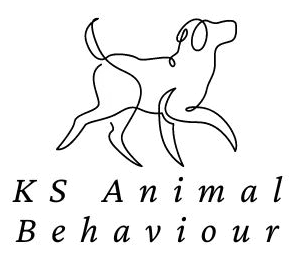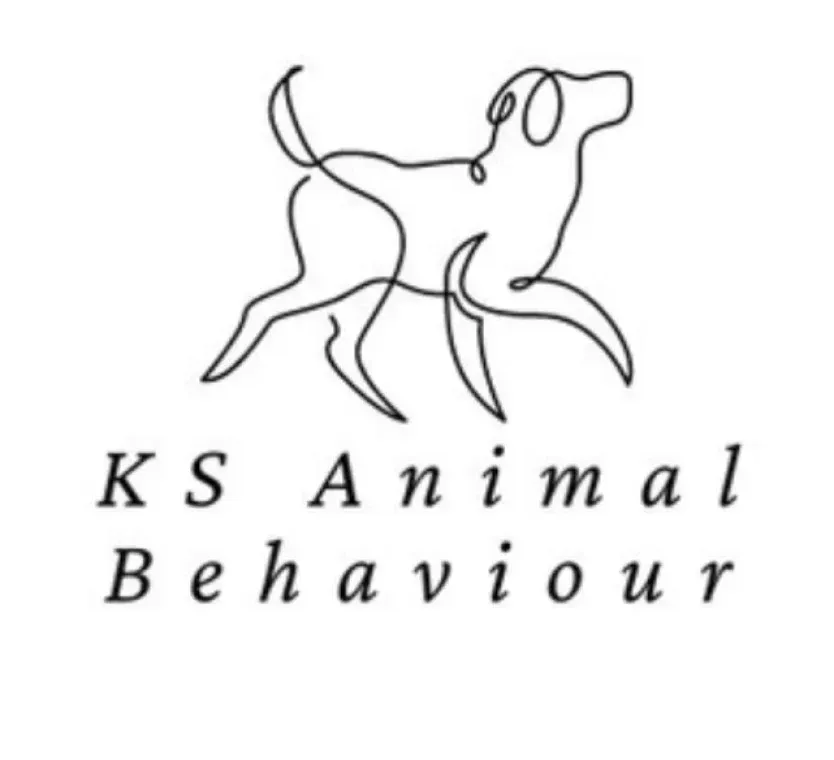

Provisional Association of Pet Behaviour Counsellors (APBC) Member
⭐️⭐️⭐️⭐️⭐️ 20+ 5-star reviews from Satisfied dog owners
Professional Dog Training in Norwich by KS Animal Behaviour
Empathetic and Experienced Trainer Specialising in Anxious and Rescue Dogs
At KS Animal Behaviour, we understand the challenges faced by empathetic and caring rescue dog guardians. Our founder, Krista Seago, is a passionate and knowledgeable dog trainer who helps build dogs' confidence and overcome anxiety and fear-based behaviours.








Empathetic and Experienced Dog Trainer in Norwich
With a background in Animal Science and Welfare, Krista has dedicated her career to spreading awareness about ethical, kind, and fun dog training and behaviour. Her experience working in dog rescue kennels, caring for and rehoming ex-racing greyhounds, has given her valuable insights into the behaviour issues that many rescue dogs face.
Krista Seago, the founder of KS Animal Behaviour, is a highly qualified and empathetic dog trainer based in Norwich. With a Masters Degree in Applied Animal Behaviour and Welfare, Krista has a deep understanding of dog behaviour and the science behind it. She is a provisional member of the Association of Pet Behaviour Counsellors (APBC), demonstrating her commitment to ongoing learning and professional development.
Key Facts About The Dog Trainer
Krista Seago, founder of KS Animal Behaviour
Provisional member of the Association of Pet Behaviour Counsellors (APBC)
Holds a Masters Degree in Applied Animal Behaviour and Welfare
Experienced as both a trainer and an anxious dog guardian
Specialises in working with anxious and rescue dogs
Offers 1:1 training, behaviour consultations, and workshops
About The Trainer
Empathetic and Experienced Dog Trainer in Norwich
Krista Seago, the founder of KS Animal Behaviour, is a highly qualified and empathetic dog trainer based in Norwich. With a Masters Degree in Applied Animal Behaviour and Welfare, Krista has a deep understanding of dog behaviour and the science behind it. She is a provisional member of the Association of Pet Behaviour Counsellors (APBC), demonstrating her commitment to ongoing learning and professional development.
What sets Krista apart is her personal experience as an anxious dog guardian. Her own rescue dog, Max, has faced numerous anxiety and fear-based behaviours, including separation related distress and reactivity. Through her journey with Max, Krista has developed effective strategies and techniques to help dogs overcome their fears and anxieties. She believes in using kind, ethical, and modern methods for long-lasting behaviour change.
What Our Clients Say
Latest Blog Posts

Emotional lives of dogs
Emotional lives of dogs

7 May 2024 | Science of dog behaviour
Do dogs experience emotions?
The theory that dogs experience emotion is highly debated in the scientific community, this may be because it is a difficult topic to research.
Researchers often avoid the topic of dog emotion out of fear of being accused of anthropomorphism (applying human thoughts, beliefs and feelings to non-humans such as animals and objects), instead opting for objective observations of behaviour. Researchers who have described animals as having emotions are often criticised of being unscientific and unreliable (Masson and McCarthy, 1995). In more modern studies the concept of animal emotions is being more accepted as research has been developed that suggest that animals do experience emotions, it is thought that dogs are capable of feeling basic emotions, comparable to a 2-year-old child, this would include emotions such as joy, anger and fear. It is thought that dogs are unable to experience complex emotions such as guilt and shame, due to the reduced size of the cortex, and that these are attributed to them when they are in fact displaying signs of fear (Animal Jobs Direct, 2017), however this doesn't mean that it won't one day be proven.
According to Gutteridge (2018), dogs’ behaviour is a direct indication of their internal emotional state. When a dog senses stimulus in the environment, physiological changes occur via hormones and neurotransmitters to give an appropriate behavioural response, therefore it is important for dogs to feel emotional for survival (Masson and McCarthy, 1995). An example of this is the fear response, which prepares the body for danger by releasing cortisol and adrenaline which cause blood rate to increase as well as other physiological symptoms.
The brain structure also indicates that dogs are capable of experiencing emotions similar to that of humans, the amygdala which is part of the limbic system, and the hippocampus is associated with fear and stress are present in the dog brain (animal jobs direct, 2017).
In studies conducted by Richter et al (2012) and Martin Seligman (Gutteridge, 2018), it was found that animals (rats and dogs) can experience a state of learned helplessness which is comparable to depression in humans, it is described as an experience of uncontrollable stress causing a state of helplessness with depression-like symptoms, where the animals no longer believe in their own abilities, so shut down. This is commonly seen in dog's that have been brought into rescue or a new home, as the new environment is so overwhelming, it is also often seen in dogs that have been trained using harsh punitive methods.
According to Mendl et al (2010), dogs are subject to either a positive or negative cognitive bias based on their affective state, making them either an optimist or pessimist, and this effects how they view ambiguous stimuli. In studies conducted on dogs with behavioural issues, such as reactivity and separation-related behaviours, it was found that these dogs are more likely to have a pessimistic personality due to their underlying negative affective state (Gutteridge, 2018). This underlying affective state also affects the dog’s decision making (Animal Jobs Direct, 2017).
Emotions and behaviour
Dogs behaviour is a direct reflection of their inner emotional state at that time (Gutteridge, 2018). Behaviour is defined as the actions and reactions of an organism dependent on the inner state and stimuli in the environment, behaviour always serves a purpose, such as survival (Animal Jobs Direct, 2017). It has been found that the cortex, which is the part of the brain which processes emotions, is five times smaller in dogs than in humans, suggesting that they do not process emotions in the same way and may experience emotions much more simplistically, therefore displaying whichever emotion they feel at that time rather than reasoning about the emotion in the way that humans do (Animal Jobs Direct, 2017).
When a dog is exposed to stimuli from the environment it causes a physiological response.
One example of emotion influencing behaviour is the fear response, fear is an intense emotion that is often recognised in dogs by escape, avoidance or defensive aggressive behaviours which are common behavioural problems often reported by owners (Morrow et al, 2015), as well as ‘shutting down’ aka learned helplessness. Learned helplessness is expressed when a dog has been exposed to painful or stressful stimuli with no way to escape, so they seem to give up its attempts at avoidance, this has been linked with symptoms of clinical depression (Animal Jobs Direct, 2017; Seligman, 1972).Anxiety is often expressed by behaviours such as separation related behaviours, for example destruction, pacing, defecating and vocalising (Mendl et al, 2010). When the fear response is activated the sympathetic pathway of the nervous system is activated, which causes a chain reaction, releasing stress hormones such as cortisol and adrenaline, these cause the blood pressure and heart rate to rise, piloerection and dilated pupils, all of which are preparing the body for danger in an adaptive response important for survival (Meldrum, 2008).
Some common behaviours observed when a dog is fearful or stressed is hypervigilance, tense body posture, turning away, vocalisation such as growling and showing teeth (Gutteridge, 2018).
It has also been found that many species behaviour is affected by their underlying affective state or ‘cognitive bias’, meaning that they make judgements in either an optimistic (positive) or pessimistic (negative) way, this has been described as an ‘unambiguous method of emotion assessment in animals’ (Richter et al, 2012). In a study by Mendl et al (2010), on 24 shelter dogs using a spatial judgement task, it was found that dogs who displayed more separation related behaviours such as vocalising, destruction and toileting, were more likely to have a pessimistic cognitive bias, which makes those dogs more predisposed to expressing anxiety-related behaviours. Similarly, a studies by Uccheddu et al (2018) and Richter et al (2012) found that when dogs and rats have a more enriched environment it can create a more optimistic cognitive bias, creating a more confident animal, and less prone to anxiety-related behaviours.
This means that dogs and other animals with an optimistic cognitive bias and positive emotional state are more likely to be calm, confident dogs which show less ‘undesirable’ behaviours compared to those with a negative affective state.
In conclusion, the studies on emotion show that emotions are highly physiological and adaptive in that they drive an animal to perform certain related behaviours, many of which are biologically important, for reproduction and survival.

Emotional lives of dogs
Emotional lives of dogs

7 May 2024 | Science of dog behaviour
Do dogs experience emotions?
The theory that dogs experience emotion is highly debated in the scientific community, this may be because it is a difficult topic to research.
Researchers often avoid the topic of dog emotion out of fear of being accused of anthropomorphism (applying human thoughts, beliefs and feelings to non-humans such as animals and objects), instead opting for objective observations of behaviour. Researchers who have described animals as having emotions are often criticised of being unscientific and unreliable (Masson and McCarthy, 1995). In more modern studies the concept of animal emotions is being more accepted as research has been developed that suggest that animals do experience emotions, it is thought that dogs are capable of feeling basic emotions, comparable to a 2-year-old child, this would include emotions such as joy, anger and fear. It is thought that dogs are unable to experience complex emotions such as guilt and shame, due to the reduced size of the cortex, and that these are attributed to them when they are in fact displaying signs of fear (Animal Jobs Direct, 2017), however this doesn't mean that it won't one day be proven.
According to Gutteridge (2018), dogs’ behaviour is a direct indication of their internal emotional state. When a dog senses stimulus in the environment, physiological changes occur via hormones and neurotransmitters to give an appropriate behavioural response, therefore it is important for dogs to feel emotional for survival (Masson and McCarthy, 1995). An example of this is the fear response, which prepares the body for danger by releasing cortisol and adrenaline which cause blood rate to increase as well as other physiological symptoms.
The brain structure also indicates that dogs are capable of experiencing emotions similar to that of humans, the amygdala which is part of the limbic system, and the hippocampus is associated with fear and stress are present in the dog brain (animal jobs direct, 2017).
In studies conducted by Richter et al (2012) and Martin Seligman (Gutteridge, 2018), it was found that animals (rats and dogs) can experience a state of learned helplessness which is comparable to depression in humans, it is described as an experience of uncontrollable stress causing a state of helplessness with depression-like symptoms, where the animals no longer believe in their own abilities, so shut down. This is commonly seen in dog's that have been brought into rescue or a new home, as the new environment is so overwhelming, it is also often seen in dogs that have been trained using harsh punitive methods.
According to Mendl et al (2010), dogs are subject to either a positive or negative cognitive bias based on their affective state, making them either an optimist or pessimist, and this effects how they view ambiguous stimuli. In studies conducted on dogs with behavioural issues, such as reactivity and separation-related behaviours, it was found that these dogs are more likely to have a pessimistic personality due to their underlying negative affective state (Gutteridge, 2018). This underlying affective state also affects the dog’s decision making (Animal Jobs Direct, 2017).
Emotions and behaviour
Dogs behaviour is a direct reflection of their inner emotional state at that time (Gutteridge, 2018). Behaviour is defined as the actions and reactions of an organism dependent on the inner state and stimuli in the environment, behaviour always serves a purpose, such as survival (Animal Jobs Direct, 2017). It has been found that the cortex, which is the part of the brain which processes emotions, is five times smaller in dogs than in humans, suggesting that they do not process emotions in the same way and may experience emotions much more simplistically, therefore displaying whichever emotion they feel at that time rather than reasoning about the emotion in the way that humans do (Animal Jobs Direct, 2017).
When a dog is exposed to stimuli from the environment it causes a physiological response.
One example of emotion influencing behaviour is the fear response, fear is an intense emotion that is often recognised in dogs by escape, avoidance or defensive aggressive behaviours which are common behavioural problems often reported by owners (Morrow et al, 2015), as well as ‘shutting down’ aka learned helplessness. Learned helplessness is expressed when a dog has been exposed to painful or stressful stimuli with no way to escape, so they seem to give up its attempts at avoidance, this has been linked with symptoms of clinical depression (Animal Jobs Direct, 2017; Seligman, 1972).Anxiety is often expressed by behaviours such as separation related behaviours, for example destruction, pacing, defecating and vocalising (Mendl et al, 2010). When the fear response is activated the sympathetic pathway of the nervous system is activated, which causes a chain reaction, releasing stress hormones such as cortisol and adrenaline, these cause the blood pressure and heart rate to rise, piloerection and dilated pupils, all of which are preparing the body for danger in an adaptive response important for survival (Meldrum, 2008).
Some common behaviours observed when a dog is fearful or stressed is hypervigilance, tense body posture, turning away, vocalisation such as growling and showing teeth (Gutteridge, 2018).
It has also been found that many species behaviour is affected by their underlying affective state or ‘cognitive bias’, meaning that they make judgements in either an optimistic (positive) or pessimistic (negative) way, this has been described as an ‘unambiguous method of emotion assessment in animals’ (Richter et al, 2012). In a study by Mendl et al (2010), on 24 shelter dogs using a spatial judgement task, it was found that dogs who displayed more separation related behaviours such as vocalising, destruction and toileting, were more likely to have a pessimistic cognitive bias, which makes those dogs more predisposed to expressing anxiety-related behaviours. Similarly, a studies by Uccheddu et al (2018) and Richter et al (2012) found that when dogs and rats have a more enriched environment it can create a more optimistic cognitive bias, creating a more confident animal, and less prone to anxiety-related behaviours.
This means that dogs and other animals with an optimistic cognitive bias and positive emotional state are more likely to be calm, confident dogs which show less ‘undesirable’ behaviours compared to those with a negative affective state.
In conclusion, the studies on emotion show that emotions are highly physiological and adaptive in that they drive an animal to perform certain related behaviours, many of which are biologically important, for reproduction and survival.
Help Your Self to A FREE Book

Welcoming Your New Rescue Dog

Confidence Building Guide For Dogs

Lead Walking
Follow Us on Instagram for more!
Frequently Asked Questions
The questions we get asked the most:
What types of behaviour issues do you address?
We provide behavior consultations for various issues including separation anxiety, reactivity, aggression, resource guarding, and fear-based behaviors.
Do you offer online training sessions?
Yes, we offer both in-person and online 1:1 training sessions to accommodate different needs and preferences.
Can you help with training a new rescue dog?
Absolutely! We offer rescue pre-arrival consultations and new rescue support to help you and your new furry friend start off on the right foot.
What qualifications do you have?
Our founder, Krista Seago, holds a Masters Degree in Applied Animal Behaviour and Welfare and is a provisional member of the APBC.
What training methods do you use?
We believe in using kind, ethical, and modern training methods that promote long-lasting behavior change.
How long does it take to see results?
The timeline for behavior change varies depending on the individual dog and the specific issue. We work closely with you to develop a personalized plan and provide ongoing support to help you achieve your goals.
Do you offer workshops or group classes?
Yes, we offer both online and in-person workshops on topics such as Canine Body Language and Understanding Reactivity. Check our website for upcoming events.
Can you help with puppy training?
Absolutely! We offer puppy foundations sessions to help you lay a solid training foundation for your new furry family member.

Privacy Policy
Terms of Services
Terms and Conditions of Services
©Copyright 2024 KS Animal Behaviour LLC | All Rights Reserved
